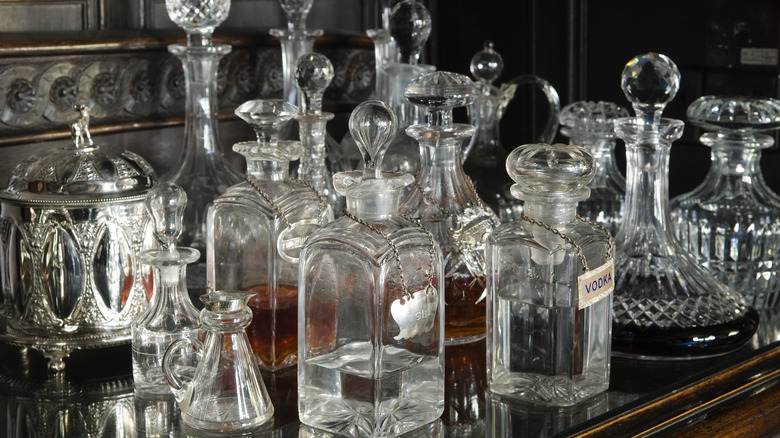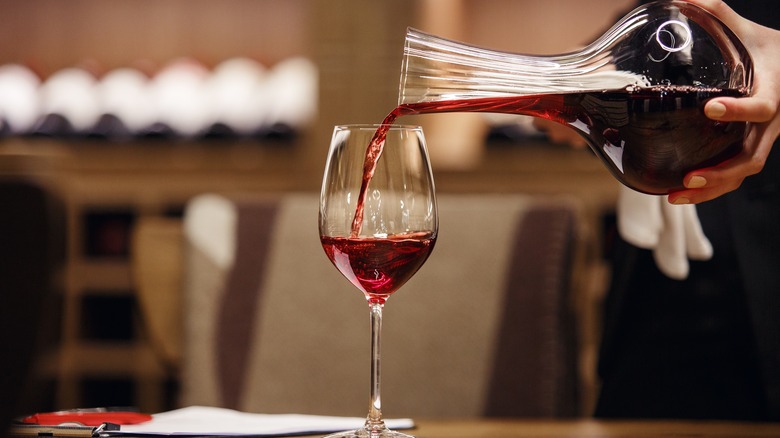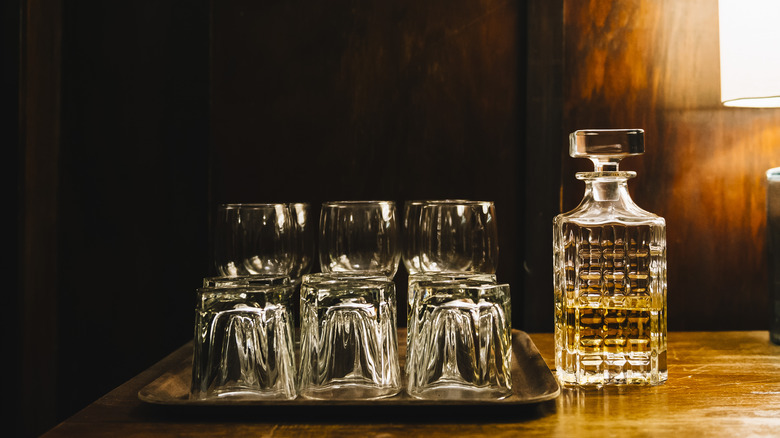How Is Decanting Different With Whiskey Vs Wine?
For those who are new to the term, decanting means pouring a liquid from one container to another. In many cases, aficionados decant wine or whiskey by tipping their bottles into a glass or crystal vessel of their choice.
The point of this practice can vary depending on the alcohol. Doing so can encourage oxidation, which impacts the aromas or tasting notes in your glass, or it might be a tactic to draw eyes to your latest crystalware purchase. Each beverage has its own reaction to decanting, however — begging the question of how pouring whiskey differs from wine. Food Republic asked experts Anna Axster and Wendelin von Schroder, co-founders of Lodestar Whiskey, to weigh in.
"Whiskey isn't as reactive to oxygen as wine, so its flavor stays pretty much the same whether you keep it in a decanter or the original bottle," they explained. In other words, while oenophiles (aka wine connoisseurs) let their grapes aerate to improve the taste or smell, whiskey lovers, for the most part, don't. Decanting the grain alcohol is instead usually done for more aesthetic reasons and storage purposes — not to expose it to air.
Different decanters and their uses
One of the major differences when it comes to decanting wine and whiskey is the goal behind the maneuver. If you decide whether or not to decant your wine, you're likely doing so right before serving up the bottle. The curving glassware is not a long-term storage vessel, but rather, a means to an end — the end being your mouth, of course. As such, many wine decanters feature wide bases to encourage maximum surface area and oxygen exposure.
Whiskey holders, on the other hand, keep out oxygen. The practice of decanting whiskey originally came about because suppliers would sell the booze in large barrels, leaving bar proprietors to figure out their own method of visually appealing and functional storage. The resulting containers featured a stoppered design still used today. The airtight opening helps stave off premature oxidation, a key to storing whiskey properly for longer periods of time.
That said, a major similarity between decanting wine and whiskey is that the process helps drinkers of both alcohols remove sediment. The little flecks at the bottom of the bottle are common in older wines and long-aged whiskeys. While it's usually safe to consume them, they can make your drink cloudy or be visually off-putting. Transferring your drink out of the bottle allows you to leave the debris behind. Plus, the stylized glassware allows you to show off your taste when you pull the vessels off the shelf.
Wine and whiskey don't respond to air the same way
A major differentiator between wine and whiskey, as pointed out by whiskey experts Anna Axster and Wendelin von Schroder, is that the two beverages respond differently to oxygen. Wine, specifically younger red wines, can hold some unpleasant or abrasive notes when they're first uncorked thanks to their oxygen-free environment. Pouring them ahead of drinking allows some of those qualities to dissipate and the air contact encourages astringent tannins to mellow.
White wines and whiskey are far less sensitive to these palate-related benefits. That's in part because they contain fewer tannins, so they don't open up or soften in the same way. Plus, the brown liquor's high alcohol content means it's less volatile and immediately reactive to oxygen's effects.
That's not to say it isn't worth exposing the spirit to air before you sip. Some connoisseurs do find themselves noticing changes to the aroma as the grain liquor sits out — though others find the results too subtle or slow to react compared to the mere 30 minutes harsh reds need to loosen up. As such, you're better off practicing sipping whiskey like a seasoned pro to fully appreciate the complex beverage.



